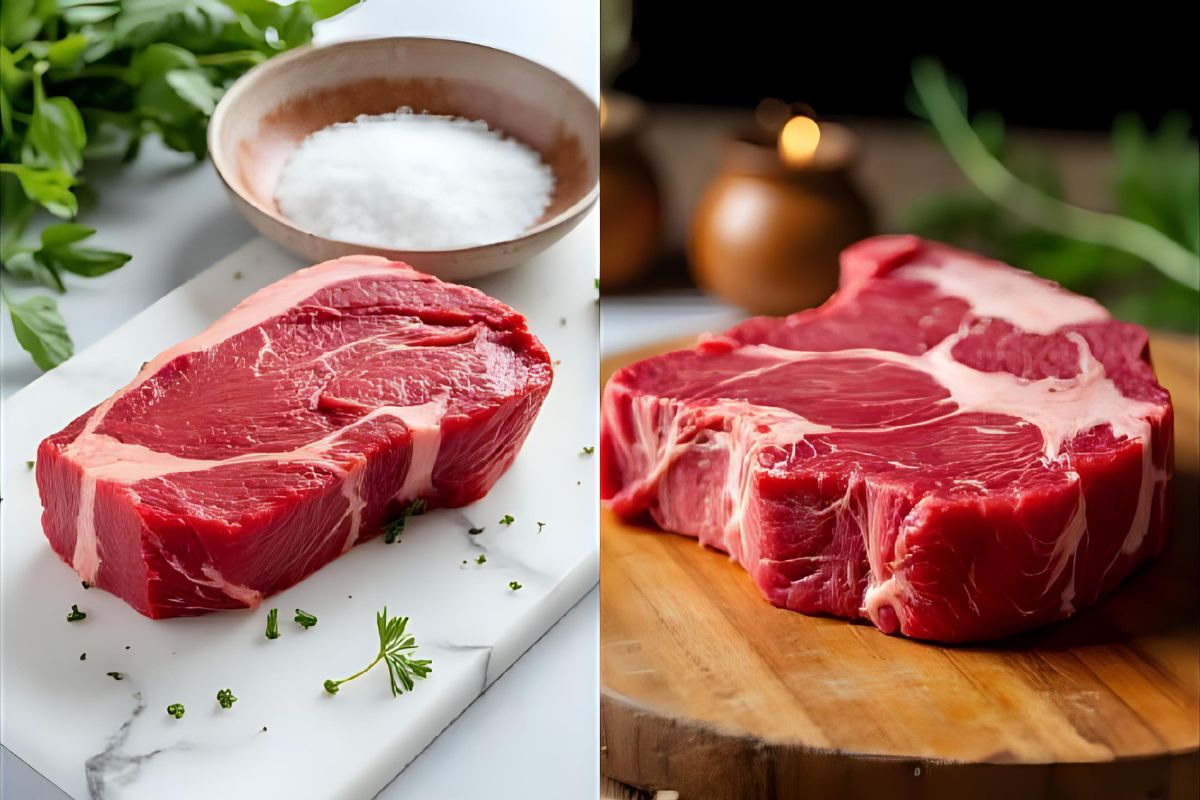Sirloin vs Ribeye: A Clear and Honest Look at Two Favourite Steak Cut

When standing at the butcher counter or flipping through a steakhouse menu, two cuts usually catch attention: Sirloin vs Ribeye. Both are known, loved, and cooked often. But they’re not the same. Each has its strengths. Each suits different meals, diets, and occasions. Whether you’re shopping on a budget, counting fat, or simply chasing flavour, it’s worth knowing how they compare.
Table of Contents
ToggleSirloin vs Ribeye – Quick Contrast
In the kitchen or at the table, ribeye vs sirloin isn’t about which one is better overall. It’s about which one fits the moment. Ribeye brings more fat and richness. Sirloin stays lean and simple. That’s the heart of it.
Texture: Soft Or Firm?
Ribeye wins in softness. It has intramuscular fat—tiny lines of fat within the muscle. That fat breaks down during cooking. It makes the meat feel silky. That doesn’t mean it melts like butter, but it does feel smooth when chewed. Some people call that luxury.
Sirloin feels meatier. There’s more bite. Not in a bad way. Just different. It holds its shape better in dishes like steak salads or fajitas. It’s the sort of steak you slice thin and toss with roasted veg. It’s not rubbery if you cook it right. It just doesn’t have that same soft finish as ribeye.
Fat Content: Which Has Less Fat, Sirloin vs Ribeye
This question comes up a lot: which has less fat, ribeye or sirloin? The answer’s clear.
Sirloin has less. It’s lean by nature. The fat usually sits along one side of the cut, not throughout the meat. You can trim it off before cooking. Or leave it on for flavour. Either way, you’re not biting into visible fat unless you want to.
Ribeye, on the other hand, has fat built in. That marbling gives it a signature taste. But it also adds calories. A standard portion of ribeye tends to bring more fat than the same size sirloin. If you’re counting macros, sirloin gives you more protein per gram of fat.
Cooking Styles And Flexibility
Ribeye handles high heat well. A ripping hot grill or cast-iron pan helps render the fat and build a crust. The inside stays juicy, even if you cook it medium or medium-well. Ribeye also plays well with a simple salt-and-pepper rub. It doesn’t need much else.
Sirloin benefits from more attention. It’s better with a marinade or a dry rub. You can pan-sear it, grill it, or even roast it in strips. Because it’s lean, it can dry out fast if overcooked. Pull it off the heat once it hits medium-rare or medium. Let it rest. Slice it against the grain. You’ll get a nice chew without it feeling tough.
Meal Planning And Leftovers
Cooking for one? Or prepping lunch for three days? Sirloin might be the better call. It’s cheaper, keeps well in the fridge, and holds its shape when reheated. You can toss slices into a rice bowl or wrap without worrying about it falling apart.
Ribeye is a one-night star. Leftovers taste fine, but the texture can go greasy or limp when cold. If you reheat ribeye, do it slowly. A quick blast in the microwave isn’t ideal. A low oven or covered pan works better. Still, it’s hard to match the fresh-off-the-pan experience of ribeye.
Cost Comparison
This one’s pretty straightforward. Ribeye costs more. Usually a few pounds more per kilo. Sometimes a lot more, depending on where you shop and whether it’s bone-in or boneless.
Sirloin sits in the mid-range. It’s not as cheap as rump, but it’s more budget-friendly than ribeye or fillet. For everyday cooking or feeding a group, sirloin stretches further.
When To Pick Ribeye
Pick ribeye when taste is a top priority. It’s what you throw on the grill for a birthday meal or date night. It doesn’t need a sauce. It doesn’t need sides to carry it. It holds its own with just a bit of salt and heat. If you’re not worried about fat or cost, it’s a great option.
When To Pick Sirloin
Sirloin is the weekday workhorse. It fits lighter diets. It suits more recipes. You can slice it thin for stir-fry, dice it for kebabs, or serve it as a full steak. It plays well with bold sauces, chimichurri, peppercorn, or garlic butter. It’s also less rich, so you won’t feel heavy after the meal.
Common Mistakes
With ribeye, the mistake is cooking it low and slow like a roast. That leaves it greasy, not juicy. You need a quick, hot cook to caramelise the fat and get the right crust.
With sirloin, the mistake is overcooking. It goes dry fast. Another one is slicing it the wrong way. Always go against the grain. That shortens the muscle fibres and gives a tender bite.
Flavour Add-Ons
Ribeye barely needs anything. But if you want more, try a touch of garlic butter at the end. Or a crack of pepper. That’s all it takes.
Sirloin welcomes extras. Think soy-garlic marinades, spicy dry rubs, or even herb-heavy dressings. You can build a whole bowl or plate around it—couscous, roasted squash, shredded greens. It adapts.
Pairings And Plates
Ribeye loves indulgent sides. Creamed spinach. Mashed potatoes. Mac and cheese. Even a glass of bold red wine like Malbec or Syrah.
Sirloin fits lighter plates. Grilled asparagus. Quinoa. Sweet potato wedges. It’s also better to serve steak with a salad or in a sandwich.
Final Verdict
There’s no winner in the Sirloin vs Ribeye debate. Just different strengths.
Pick ribeye when:
- You want something soft and rich
- You’re making steak the star of the meal
- You’re celebrating or feel like treating yourself
Pick sirloin when:
- You want something lean
- You’re planning ahead or watching your budget
- You need a steak that works well in a recipe
You don’t have to choose one forever. Try both. Cook them different ways. Notice how each one reacts to heat, seasoning, and slicing. It’s not about loyalty. It’s about knowing your options.
Published by Azura Everhart
I'm Azura Everhart, Digital Marketing Specialist, with over five years of experience helping brands grow through smart, data-backed digital strategies. Holding a Bachelor's in Business Administration and a Diploma in Digital Marketing Strategy, I specialize in building campaigns that connect, convert, and create lasting impact. I also write about the latest in business innovation and health trends, aiming to make complex ideas practical and engaging for modern audiences. View more posts
Recent Post
Golf Resorts In Greece – Something’s Changing

Rediscover Luxury and Nature at Hotel Xcaret Mexico






